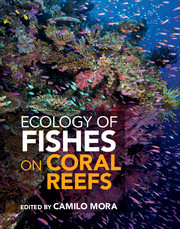Book contents
- Frontmatter
- Contents
- Preface
- Foreword
- List of contributors
- PART I BASIC ECOLOGY
- PART II PATTERNS AND PROCESSES
- PART III HUMAN FINGERPRINTS
- PART IV CONSERVATION
- PART V DEBATES AND PARADIGM SHIFTS
- 23 Is dispersal of larval reef fishes passive?
- 24 Density dependence and independence and the population dynamics of coral reef fishes
- 25 Equilibrial versus non-equilibrial dynamics in coral reef fishes
- 26 Cryptic density dependence: integrating supply-side ecology with population regulation
- 27 Priority effects
- 28 Inverted trophic pyramids
- 29 Shifting baselines in coral reef fishes
- 30 Pluralism explains diversity in the Coral Triangle
- 31 Reef fish biogeographical regions
- 32 Size and sex change
- 33 Quantifying reef fishes: bias in observational approaches
- 34 Seascape ecology of fishes on coral reefs
- 35 The future for coral reef fishes
- 36 Perpetual struggle for conservation in a crowded world and the needed paradigm shift for easing ultimate burdens
- References
- Index
31 - Reef fish biogeographical regions
from PART V - DEBATES AND PARADIGM SHIFTS
Published online by Cambridge University Press: 05 May 2015
- Frontmatter
- Contents
- Preface
- Foreword
- List of contributors
- PART I BASIC ECOLOGY
- PART II PATTERNS AND PROCESSES
- PART III HUMAN FINGERPRINTS
- PART IV CONSERVATION
- PART V DEBATES AND PARADIGM SHIFTS
- 23 Is dispersal of larval reef fishes passive?
- 24 Density dependence and independence and the population dynamics of coral reef fishes
- 25 Equilibrial versus non-equilibrial dynamics in coral reef fishes
- 26 Cryptic density dependence: integrating supply-side ecology with population regulation
- 27 Priority effects
- 28 Inverted trophic pyramids
- 29 Shifting baselines in coral reef fishes
- 30 Pluralism explains diversity in the Coral Triangle
- 31 Reef fish biogeographical regions
- 32 Size and sex change
- 33 Quantifying reef fishes: bias in observational approaches
- 34 Seascape ecology of fishes on coral reefs
- 35 The future for coral reef fishes
- 36 Perpetual struggle for conservation in a crowded world and the needed paradigm shift for easing ultimate burdens
- References
- Index
Summary
The first 100 years of research devoted to marine regions and provinces led to knowledge involving species distribution patterns, location of boundaries, and the extent of endemism. Within the past 40 years, it became apparent that regions and provinces were not static entities but had a dynamic relationship that reflected continuous changes in the distribution of species. It was recognized that vagile species could negotiate biogeographic barriers and were able to invade from places of high species diversity into less diverse areas. Within the past 5 years, it became apparent that invasive species were successful because they were accommodated by native species that occupied the appropriate habitats. Invasion success explained why certain dominant species were able to achieve broad geographic ranges. Finally, due to advances in phylogeography, we became aware that a few peripheral fish species had been able to invade toward instead of away from centers of higher diversity.
Our modern concept of marine biogeographical regions began with the work of James Dwight Dana, an American geologist, mineralogist, and naturalist. As a young man, Dana joined the United States Exploring Expedition to the South Seas. He served 4 years (1838–42) as a geologist but also undertook much of the zoological work. As the result of his discoveries on the corals and crustaceans, he was convinced that sea surface temperature was the important factor that determined distributional patterns. Dana used isocrymes (lines of mean minimum temperature for the coldest month) to explain the geographical separation of species groups, and published an Isocrymal Chart (map) that illustrated the worldwide distribution of marine animals [612]. He was the first to observe that the latitudinal distribution of marine animals was restricted by the cold of winter, not the average temperature. Dana's chart laid the foundation for the biogeographic regions that are recognized today.
Edward Forbes, the English naturalist who first explored the depth distribution of marine organisms, also drew a map of marine life distribution that was published in Alexander K. Johnston's The Physical Atlas of Natural Phenomena [832].
- Type
- Chapter
- Information
- Ecology of Fishes on Coral Reefs , pp. 264 - 266Publisher: Cambridge University PressPrint publication year: 2015



